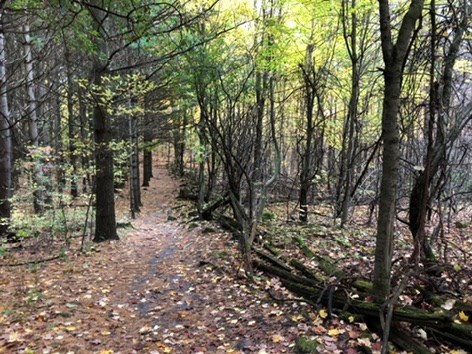“I love walking here, it feels like I’m so far out of the city.”
Guelph resident Clara Vidotto has been walking the Starkey Hill trail since she was a child. Its relative remoteness from city noise and pollution, as well as year-round accessibility are what gives it its charm, she says.
The four-kilometre loop, located just outside of Guelph on Arkell Road, is the highest point in the area, with the ‘summit’ sitting at 380 metres above sea level. But what the trail lacks in substantial elevation, it more than makes up for with beautiful hardwood forests, clean and well-kept trails, and a beautiful panoramic view of Basilica of Our Lady.
The trail is named after the Starkey family; American settlers who purchased the land in 1849 to build a farm. John Starkey and his wife Margaret Murray had five children and in 1894, their only son, James, took over the farm and bought an adjoining 100 acres to breed carriage horses. James was successful in this venture, exhibiting his horses in Toronto and at other shows.
Upon James’ death in 1911, the farm was managed by his wife and three children who eventually sold the 37-acre plot of land to the Grand River Conservation Authority (GRCA) in 1972 for protection of the underlying groundwater. Not long after, it would be converted to today’s beloved hiking trail paying homage to an important local family and a piece of history.
Today, Starkey Hill is jointly managed by the GRCA and the Guelph Hiking Trail Club. Jim Hoare is the club’s “trail captain” and he regularly walks the path to clear minor branches and debris.
“Now is the best time of year to visit,” said Hoare. “The colours are just beautiful.”
Most of the area is pine plantation, but other trees including sugar maples, beech, white ash, iron wood and black cherry trees give the trail an impressive palate of colours during the fall season.
Hikers follow a well-worn path along steep forested slopes and wetlands. Clear markers make it easy to navigate, and a new feature of the trail is a collection of interpretive signs for the digital age; QR (quick response) codes that allow smartphone users to connect to a webpage that provides a description of the viewpoint.
The wetlands, for example, that appear deeper into the trail are little ponds known as ‘kettle lakes.’ These are remnants of glacial depressions during the ice age over 10,000 years ago. Rain and snow melt collect in the kettles and replenish groundwater supply, which serves an important ecological purpose. But those hikers who are more interested in wildlife than geological history can keep an eye out for snakes, hawks, turtles, porcupines and moles as well.
During any season, the trail draws all sorts of walkers and runners of all ages. Many are accompanied by pets (on a leash) and children. Starkey Hill is busiest from May to October, when cars often overflow from the small parking lot onto the side of Arkell Road.
Hoare and his team of volunteers at the GRCA and the hiking club work tirelessly to share this beautiful trail with the Guelph community. As a gesture of respect for nature and wildlife, they have just one wish: “Please take only pictures and leave only footprints.”



.png;w=120;h=80;mode=crop)